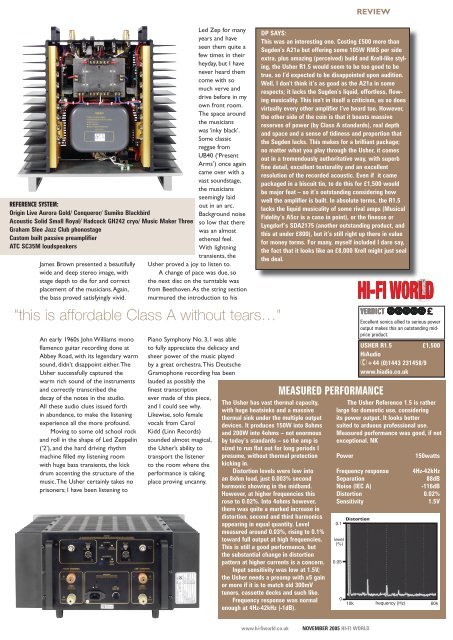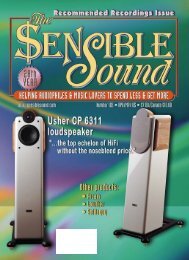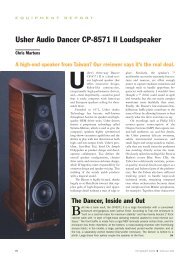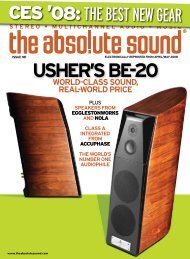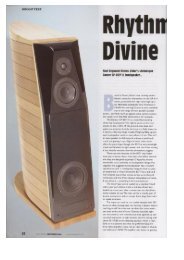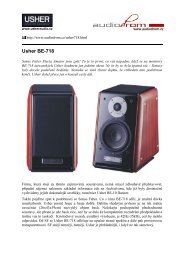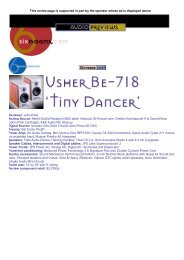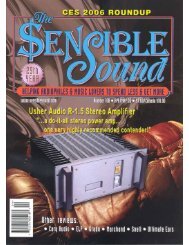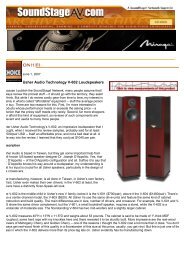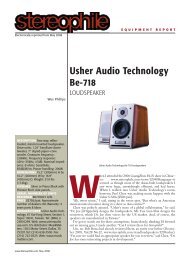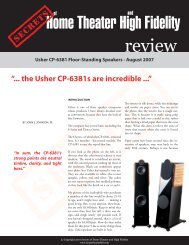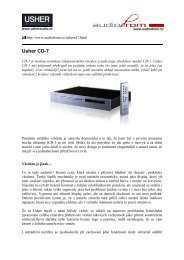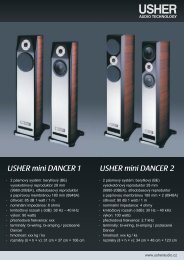hi-fi world - Usher Audio
hi-fi world - Usher Audio
hi-fi world - Usher Audio
You also want an ePaper? Increase the reach of your titles
YUMPU automatically turns print PDFs into web optimized ePapers that Google loves.
REFERENCE SYSTEM:<br />
Origin Live Aurora Gold/ Conqueror/ Sumiko Blackbird<br />
Acoustic Solid Small Royal/ Hadcock GH242 cryo/ Music Maker Three<br />
Graham Slee Jazz Club phonostage<br />
Custom built passive preampli<strong>fi</strong>er<br />
ATC SC35M loudspeakers<br />
James Brown presented a beautifully<br />
wide and deep stereo image, with<br />
stage depth to die for and correct<br />
placement of the musicians. Again,<br />
the bass proved satisfyingly vivid.<br />
An early 1960s John Williams mono<br />
flamenco guitar recording done at<br />
Abbey Road, with its legendary warm<br />
sound, didn’t disappoint either. The<br />
<strong>Usher</strong> successfully captured the<br />
warm rich sound of the instruments<br />
and correctly transcribed the<br />
decay of the notes in the studio.<br />
All these audio clues issued forth<br />
in abundance, to make the listening<br />
experience all the more profound.<br />
Moving to some old school rock<br />
and roll in the shape of Led Zeppelin<br />
(‘2’), and the hard driving rhythm<br />
mac<strong>hi</strong>ne <strong>fi</strong>lled my listening room<br />
with huge bass transients, the kick<br />
drum accenting the structure of the<br />
music. The <strong>Usher</strong> certainly takes no<br />
prisoners; I have been listening to<br />
Led Zep for many<br />
years and have<br />
seen them quite a<br />
few times in their<br />
heyday, but I have<br />
never heard them<br />
come with so<br />
much verve and<br />
drive before in my<br />
own front room.<br />
The space around<br />
the musicians<br />
was ‘inky black’.<br />
Some classic<br />
reggae from<br />
UB40 (‘Present<br />
Arms’) once again<br />
came over with a<br />
vast soundstage,<br />
the musicians<br />
seemingly laid<br />
out in an arc.<br />
Background noise<br />
so low that there<br />
was an almost<br />
ethereal feel.<br />
With lightning<br />
transients, the<br />
<strong>Usher</strong> proved a joy to listen to.<br />
A change of pace was due, so<br />
the next disc on the turntable was<br />
from Beethoven. As the string section<br />
murmured the introduction to <strong>hi</strong>s<br />
"t<strong>hi</strong>s is affordable Class A without tears…"<br />
Piano Symphony No. 3, I was able<br />
to fully appreciate the delicacy and<br />
sheer power of the music played<br />
by a great orchestra. T<strong>hi</strong>s Deutsche<br />
Gramophone recording has been<br />
lauded as possibly the<br />
<strong>fi</strong>nest transcription<br />
ever made of t<strong>hi</strong>s piece,<br />
and I could see why.<br />
Likewise, solo female<br />
vocals from Carol<br />
Kidd (Linn Records)<br />
sounded almost magical,<br />
the <strong>Usher</strong>’s ability to<br />
transport the listener<br />
to the room where the<br />
performance is taking<br />
place proving uncanny.<br />
REVIEW<br />
DP SAYS:<br />
CONCLUSION<br />
T<strong>hi</strong>s was an interesting one. Costing £500 more than<br />
An extremely impressive bit of kit, by<br />
Sugden’s A21a but offering some 105W RMS per side<br />
any standards, the <strong>Usher</strong> R1.5 makes<br />
extra, plus amazing (perceived) build and Krell-like styl-<br />
an excellent ‘do-it-all’ <strong>hi</strong>gh end power<br />
ing, the <strong>Usher</strong> R1.5 would seem to be too good to be<br />
amp. From a consumer’s point of<br />
true, so I’d expected to be disappointed upon audition.<br />
view it’s affordable Class A without<br />
Well, I don’t t<strong>hi</strong>nk it’s as good as the A21a in some<br />
tears, as you get none of the speaker<br />
respects; it lacks the Sugden’s liquid, effortless, flow-<br />
matc<strong>hi</strong>ng issues that the Sugden A21a<br />
ing musicality. T<strong>hi</strong>s isn’t in itself a criticism, as so does<br />
presents (due to its understandable<br />
virtually every other ampli<strong>fi</strong>er I’ve heard too. However,<br />
lack of power). T<strong>hi</strong>s behemoth will<br />
the other side of the coin is that it boasts massive<br />
drive pretty much anyt<strong>hi</strong>ng without<br />
reserves of power (by Class A standards), real depth<br />
so much as batting an eyelid; w<strong>hi</strong>ch is<br />
and space and a sense of tidiness and proportion that<br />
impressive<br />
the Sugden lacks. T<strong>hi</strong>s makes for a brilliant package;<br />
no matter what you play through the <strong>Usher</strong>, it comes<br />
out in a tremendously authoritative way, with superb<br />
<strong>fi</strong>ne detail, excellent texturality and an excellent<br />
resolution of the recorded acoustic. Even if it came<br />
packaged in a biscuit tin, to do t<strong>hi</strong>s for £1,500 would<br />
be major feat – so it’s outstanding considering how<br />
well the ampli<strong>fi</strong>er is built. In absolute terms, the R1.5<br />
lacks the liquid musicality of some rival amps (Musical<br />
Fidelity’s A5cr is a case in point), or the <strong>fi</strong>nesse or<br />
Lyngdorf’s SDA2175 (another outstanding product, and<br />
t<strong>hi</strong>s at under £800), but it’s still right up there in value<br />
for money terms. For many, myself included I dare say,<br />
the fact that it looks like an £8,000 Krell might just seal<br />
the deal.<br />
The <strong>Usher</strong> has vast thermal capacity,<br />
with huge heatsinks and a massive<br />
thermal sink under the multiple output<br />
devices. It produces 150W into 8ohms<br />
and 200W into 4ohms – not enormous<br />
by today’s standards – so the amp is<br />
sized to run flat out for long periods I<br />
presume, without thermal protection<br />
kicking in.<br />
Distortion levels were low into<br />
an 8ohm load, just 0.003% second<br />
harmonic showing in the midband.<br />
However, at <strong>hi</strong>gher frequencies t<strong>hi</strong>s<br />
rose to 0.02%. Into 4ohms however,<br />
there was quite a marked increase in<br />
distortion, second and t<strong>hi</strong>rd harmonics<br />
appearing in equal quantity. Level<br />
measured around 0.03%, rising to 0.1%<br />
toward full output at <strong>hi</strong>gh frequencies.<br />
T<strong>hi</strong>s is still a good performance, but<br />
the substantial change in distortion<br />
pattern at <strong>hi</strong>gher currents is a concern.<br />
Input sensitivity was low at 1.5V;<br />
the <strong>Usher</strong> needs a preamp with x5 gain<br />
or more if it is to match old 300mV<br />
tuners, cassette decks and such like.<br />
Frequency response was normal<br />
enough at 4Hz-42kHz (-1dB).<br />
VERDICT<br />
MEASURED PERFORMANCE<br />
)<br />
£<br />
Excellent sonics allied to serious power<br />
output makes t<strong>hi</strong>s an outstanding midprice<br />
product.<br />
USHER R1.5 £1,500<br />
Hi<strong>Audio</strong><br />
+44 (0)1443 231458/9<br />
www.<strong>hi</strong>adio.co.uk<br />
The <strong>Usher</strong> Reference 1.5 is rather<br />
large for domestic use, considering<br />
its power output. It looks better<br />
suited to arduous professional use.<br />
Measured performance was good, if not<br />
exceptional. NK<br />
Power<br />
150watts<br />
Frequency response 4Hz-42kHz<br />
Separation<br />
88dB<br />
Noise (IEC A)<br />
-116dB<br />
Distortion 0.02%<br />
Sensitivity 1.5V<br />
0.1<br />
level<br />
(%)<br />
0.05<br />
HI-FI WORLD<br />
Distortion<br />
0<br />
10k frequency (Hz)<br />
60k<br />
www.<strong>hi</strong>-<strong>fi</strong><strong>world</strong>.co.uk NOVEMBER 2005 HI-FI WORLD<br />
P34-P35 subbed$.indd 35 30/4/07 11:28:59


